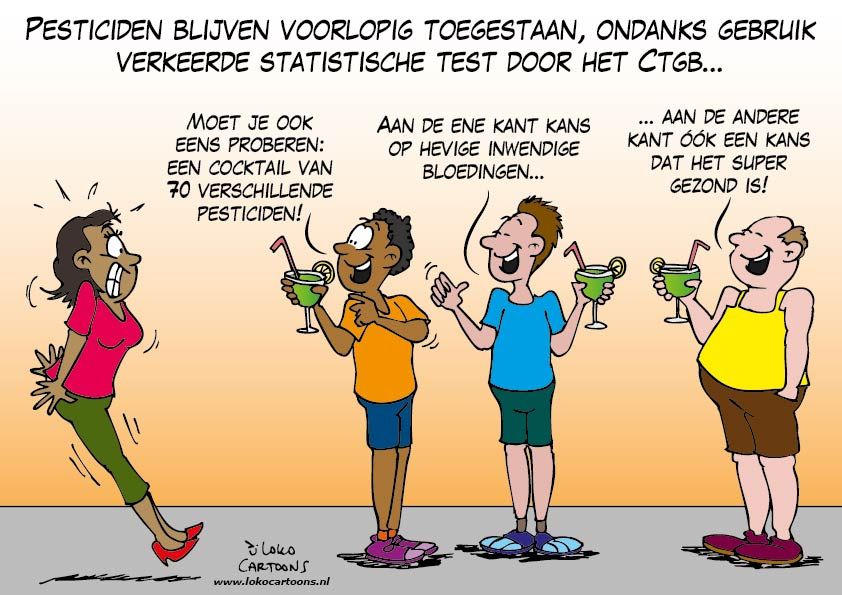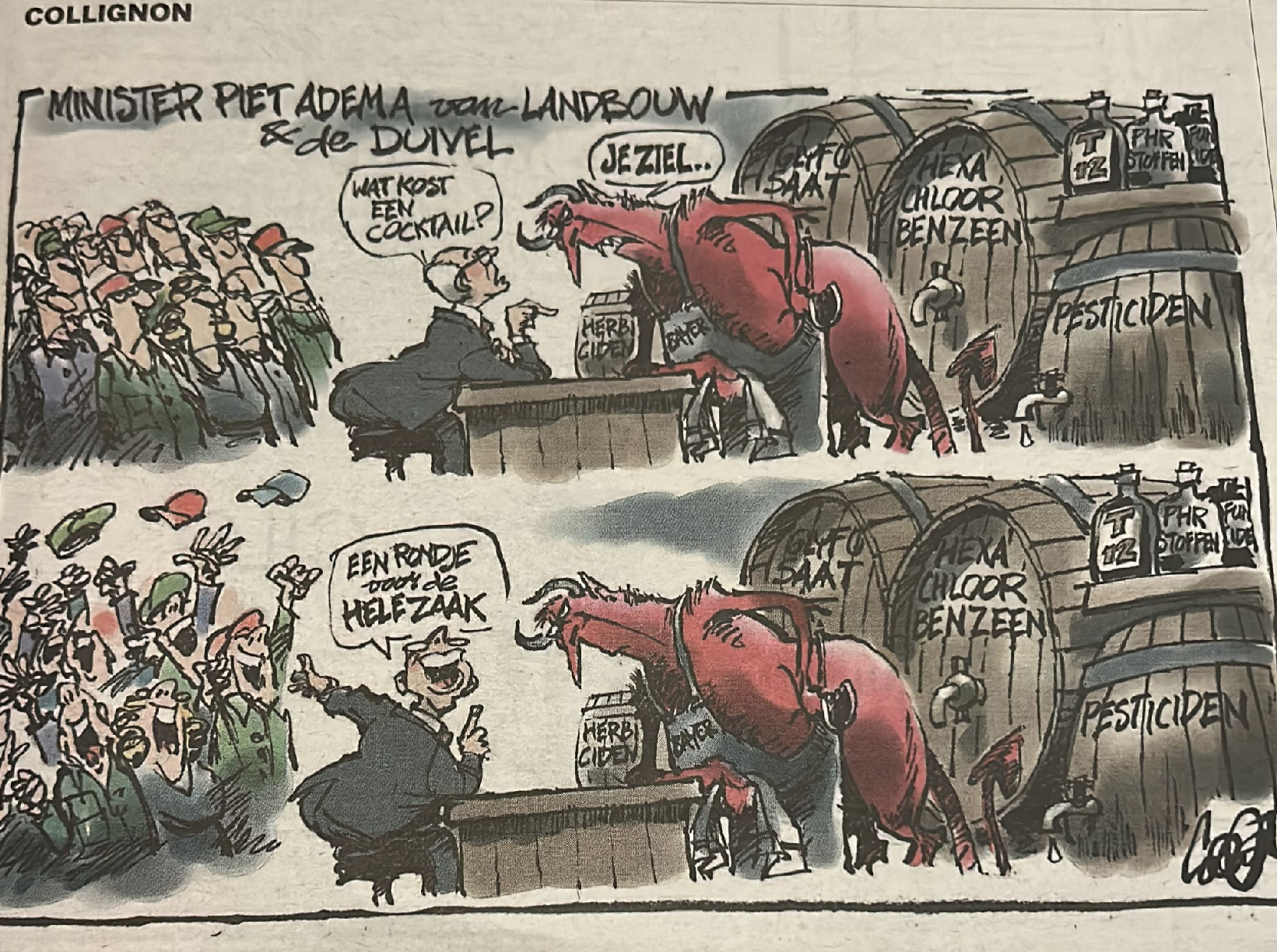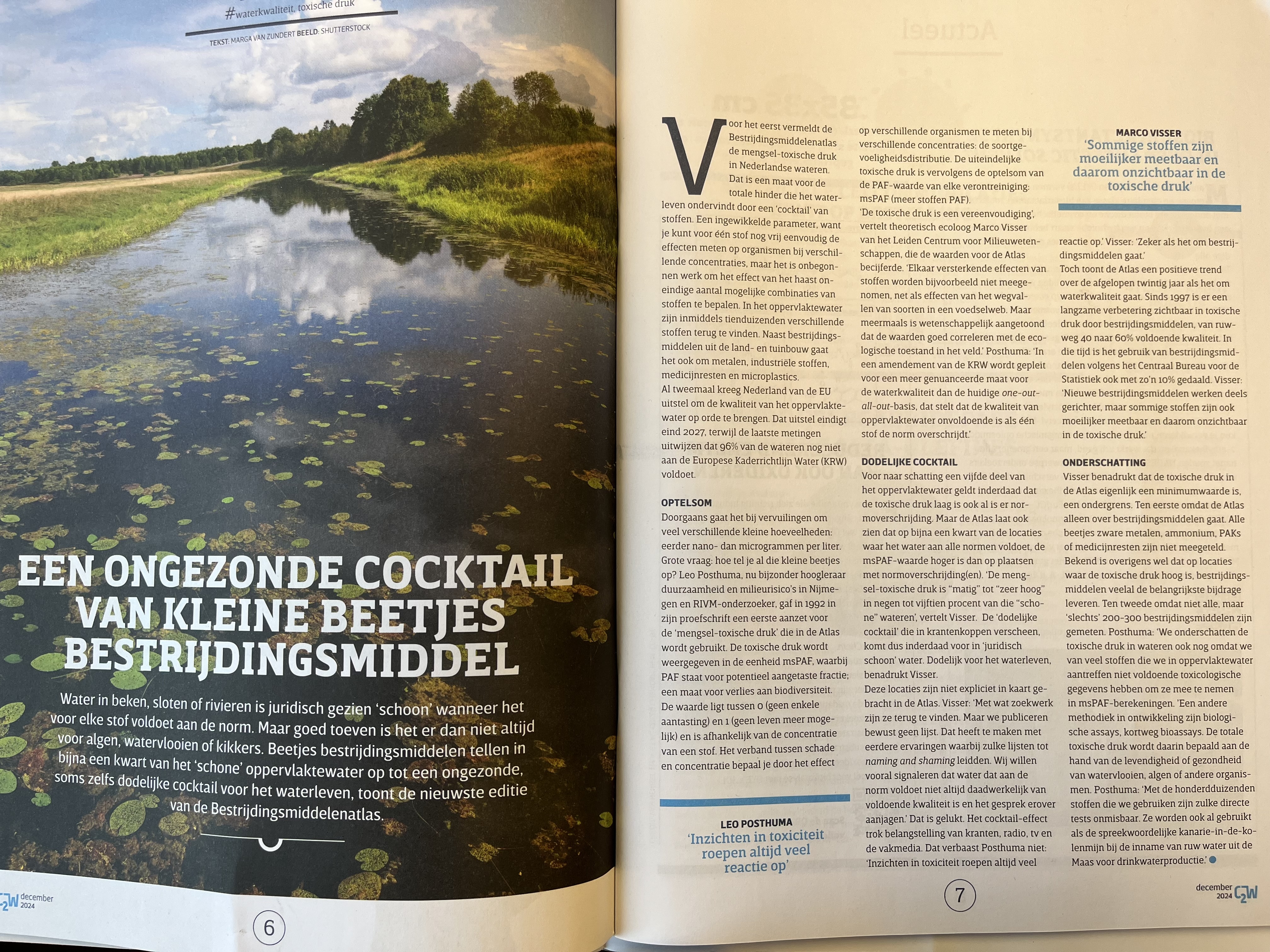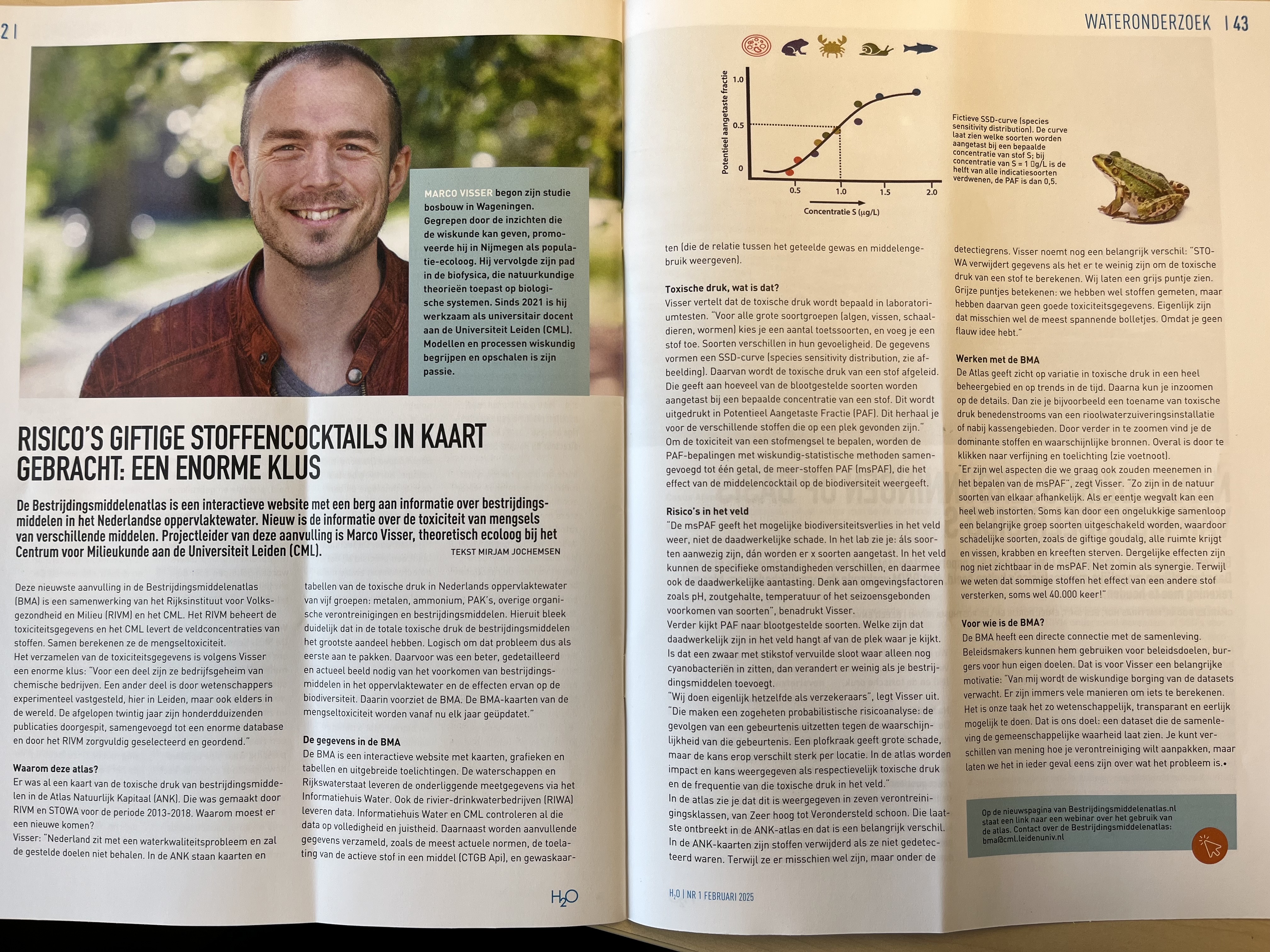In the news
The Multi-Scale Ecology Team
News & Media Mentions
Impact on policy and legislation
-
Leiden University: Our work on building the Pesticide Atlas becomes instrumental in enhancing control over harmful substances in water.
Read more
-
Official Governement Notices: New pesticide regulations are being announced, which uses our ongoing work, reflecting our research's impact on policy and society.
Read more
-
Trouw: Using our post-registration monitoring, curated data and calculations, the Dutch pesticide-registration watchdog will now intervene when toxic substances repeatedly pollute water, prompting legislative action.
Read more
-
CTGB: Regulatory authorities address exceedances in pesticide authorization norms using data.
Read more
-
Dutch Legislation: Legislation now explicitly mentions our tools, in laws that establishes standards to use post-registration monitoring data to protect public health and the environment.
Read more
-
Minister of Infrastructure and Water Management reacts to our resarch: 'We will simply have to improve our lives in many sectors in the Netherlands'.
Read more
From Research to Parliament: Atlas in Questions, Debates, and Policy
-
Research from the Muselab and the Bestrijdingsmiddelenatlas has been taken up directly in Dutch policymaking.
It has been cited in parliamentary questions, ministerial policy letters, national action plans, and parliamentary committee debates,
underlining its role as an growing authoritative source of information in political decision-making.
(Kamerstukken II 2021/22, 851; Kamerstukken II 2021/22, 579; Kamerstukken II 2020/21, 35 756 nr. 11;
Kamerstukken II 2023/24, 653; Kamerstukken II 2023/24, 1500; Minister IenW 2024; Kamerstukken II 27 625 nr. 589 (2022);
Kamerstukken II 27 858 nr. 673 (2024))
The Pesticide Atlas: A Common Truth for Societal Debate
-
Our Bestrijdingsmiddelenatlas compiles and analyzes millions of records spanning 25 years to offer an
objective, data‐driven perspective on the environmental impacts of chemical mixtures. This tool serves as a
unifying reference—establishing a common truth that informs policy, supports public debate, and drives
societal efforts toward cleaner water and safer environments. Read the article by Mare..
Lianas from space and a "liana pandemic"?
From Research to Parliament: Atlas in Questions, Debates, and Policy
Research from the Muselab and the Bestrijdingsmiddelenatlas has been taken up directly in Dutch policymaking. It has been cited in parliamentary questions, ministerial policy letters, national action plans, and parliamentary committee debates, underlining its role as an growing authoritative source of information in political decision-making. (Kamerstukken II 2021/22, 851; Kamerstukken II 2021/22, 579; Kamerstukken II 2020/21, 35 756 nr. 11; Kamerstukken II 2023/24, 653; Kamerstukken II 2023/24, 1500; Minister IenW 2024; Kamerstukken II 27 625 nr. 589 (2022); Kamerstukken II 27 858 nr. 673 (2024))
The Pesticide Atlas: A Common Truth for Societal Debate
Our Bestrijdingsmiddelenatlas compiles and analyzes millions of records spanning 25 years to offer an objective, data‐driven perspective on the environmental impacts of chemical mixtures. This tool serves as a unifying reference—establishing a common truth that informs policy, supports public debate, and drives societal efforts toward cleaner water and safer environments. Read the article by Mare..
Global coverage followed two companion papers: a pantropical meta-analysis by PhD student Manuela A. Rueda-Trujillo showing a consistent pantropical liana increase (media called it a “liana pandemic” Read the study), and a mechanistic study explaining why satellites can detect lianas (Read the study).
Global Media Coverage
- NPO Radio 1 (Met het Oog op Morgen): PI Marco Visser discusses research on lianas, explaining why they may be increasing (final 10 to 8 min). Listen
- France 24 (YouTube): Report featuring Leiden research on the global liana surge and satellite detection of lianas (in French). Watch the segment
- Phys.org (EN): “Lianas are taking over the rainforests, and it’s visible from space.” Read more
- SciTechDaily (EN): “This ‘Cheater’ Plant Is Taking Over the Rainforests – And It’s Visible From Space.” Read more
- New Scientist (NL): “Door lianenpandemie slaan tropische bossen veel minder CO₂ op.” Lees meer
- Scientias (NL): “Tropische bossen kampen met ‘lianenpandemie’ die zelfs vanuit de ruimte zichtbaar is.” Lees meer
- La Jornada / Europa Press (ES): “Bosques tropicales del mundo, amenazados por pandemia de lianas.” Leer más
- Infobae (ES): “Las lianas devoran los bosques tropicales y se ven desde el espacio.” Leer más
- Diário de Notícias / Lusa (PT): “Lianas devoram florestas tropicais e podem ser vistas do espaço.” Ler mais
- Al-Mustaqbal Al-Akhdar (AR): “غزو النباتات المتسلقة للغابات.. خطر بيئي يتفاقم عالميًا” (“Invasion of climbing plants in forests… an escalating global environmental threat”) – Arabic coverage of Leiden’s liana studies, highlighting the global “pandemic of lianas” and why satellites can detect them. Read more
Radio
Articles
Toxic Mixtures (2024 to 2025)
-
Political Cartoons

Our work demonstrated that one-sided statistical testing is essential in pesticide cancer risk assessment,
leading regulators to acknowledge that past assessments had used inappropriate methods;
the public debate was even captured in a cartoon by Lodewijk Koster (featuring our work on toxic mixtures and two-sided testing).
View in Trouw

Preview: Political cartoon featuring our research on chemical cocktails, and "potential high risk" and "toxic 12"
groups (PHR and T12).
By Jos Collignon, in the Volkskrant 30 September 2023.
Interviews


Preview: These magazine interviews from H20 Water Magazine and C2W Chemicals Magazine showcase our work on chemical cocktails in the Netherlands—calculating the effects from 10,000,000 records of individual chemicals over 25 years.
-
Radio
NPO Radio 1: CML director Martina Vijver discusses our work on cocktails of approved pesticides - which can lead to an unintended declines in aquatic life.
Listen
Articles
-
Dagblad van het Noorden: Reports on our research showing how a mixture of pesticides in surface waters can form a "toxic cocktail" that raises concerns about water quality.
Read more
-
NRC: Highlights our work on the compounded toxicity of chemical mixtures, emphasizing that approved substances can become extra harmful when combined.
Read more
-
Leeuwarder Courant: Reports on our findings of a “deadly cocktail” in surface waters, underlining urgent environmental implications.
Read more
-
NU.nl: Reports that pesticide mixtures in ditches and lakes create a toxic combination, posing challenges for environmental monitoring.
Read more
-
BNNVARA Vroege Vogels: Coverage of how a chemical “cocktail” in surface water proves more toxic than individual substances alone.
Read more
-
Platform Bloem: Highlights the toxic pressure of combined pesticides.
Read more
-
Groenten Nieuws (1): Details how a mixture of substances in surface water is more toxic than any single chemical alone.
Read more
-
Groenten Nieuws (2): Announces the 2023 update to our Pesticide Atlas, including new measurement data on surface water quality.
Read more
-
BPnieuws: Reiterates findings on how a cocktail of substances in surface water proves more hazardous than individual substances.
Read more
-
De Natuurweide: Describes our work on the toxicity of combined pesticides, noting a more severe impact than isolated chemicals.
Read more
-
Blik Op Nieuws: Reports on our work calculating how surface water substances can together create a lethal cocktail, influencing aquatic biodiversity.
Read more
-
Stichting JAS: Reports that persistent chemical mixes in ditches and canals pose significant environmental threats.
Read more
-
Waterforum: Highlights the inclusion of toxic pressure indicators in the updated Pesticide Atlas, showing more potent mixtures than anticipated.
Read more
-
Klimaatweb: Stresses that cocktails of substances in surface water are more dangerous than any single chemical, urging policy action.
Read more
-
Biociden.nl: Announces the newly updated Pesticide Atlas and highlights the environmental impact of chemical mixtures.
Read more
-
Boom in Business: Notes the 2023 Pesticide Atlas update and its key findings on the persistent toxicity of combined chemicals.
Read more
-
KRO-NCRV Pointer (BMA Focus): Investigates illegal pesticides, using our Pesticide Atlas data to spotlight environmental risks.
Read more
-
YouTube (Podcast): Features a discussion on pesticide mixtures and water quality concerns, highlighting our latest Pesticide Atlas findings.
Watch
-
KRO-NCRV Pointer (Water in Noord-Holland): Links to our data used in reporting on contaminated water containing worrying and forbidden substances.
Read more
Candidates for Substitution in Recreational and Swimming Waters (2023)
-
Binnenlands Bestuur: Discusses the persistent issue of pesticides in water across 153 sites, highlighting chemicals that may be viable candidates for substitution in recreational waters.
Read more
-
Unie van Waterschappen: Reports on the excessive presence of crop protection products in surface waters, prompting calls for alternative, safer substances.
Read more
-
Universiteit Leiden: Finds that high levels of pesticides in Dutch swimming and nature waters remain a persistent problem.
Read more
-
Natuur en Milieu Report: A detailed report discussing the impact of pesticides in and around nature and recreational waters.
Read more
-
NOS: Highlights alarmingly high levels of agricultural chemicals in surface waters, underscoring the need for safer substitutes.
Read more
-
NU.nl (Klimaat): Reports that water in nature and recreational areas is frequently contaminated with pesticides, further supporting the case for substitution.
Read more
Political Cartoons

Our work demonstrated that one-sided statistical testing is essential in pesticide cancer risk assessment, leading regulators to acknowledge that past assessments had used inappropriate methods; the public debate was even captured in a cartoon by Lodewijk Koster (featuring our work on toxic mixtures and two-sided testing). View in Trouw

Preview: Political cartoon featuring our research on chemical cocktails, and "potential high risk" and "toxic 12" groups (PHR and T12). By Jos Collignon, in the Volkskrant 30 September 2023.
Interviews


Preview: These magazine interviews from H20 Water Magazine and C2W Chemicals Magazine showcase our work on chemical cocktails in the Netherlands—calculating the effects from 10,000,000 records of individual chemicals over 25 years.
Radio
NPO Radio 1: CML director Martina Vijver discusses our work on cocktails of approved pesticides - which can lead to an unintended declines in aquatic life. ListenArticles
- Binnenlands Bestuur: Discusses the persistent issue of pesticides in water across 153 sites, highlighting chemicals that may be viable candidates for substitution in recreational waters. Read more
- Unie van Waterschappen: Reports on the excessive presence of crop protection products in surface waters, prompting calls for alternative, safer substances. Read more
- Universiteit Leiden: Finds that high levels of pesticides in Dutch swimming and nature waters remain a persistent problem. Read more
- Natuur en Milieu Report: A detailed report discussing the impact of pesticides in and around nature and recreational waters. Read more
- NOS: Highlights alarmingly high levels of agricultural chemicals in surface waters, underscoring the need for safer substitutes. Read more
- NU.nl (Klimaat): Reports that water in nature and recreational areas is frequently contaminated with pesticides, further supporting the case for substitution. Read more